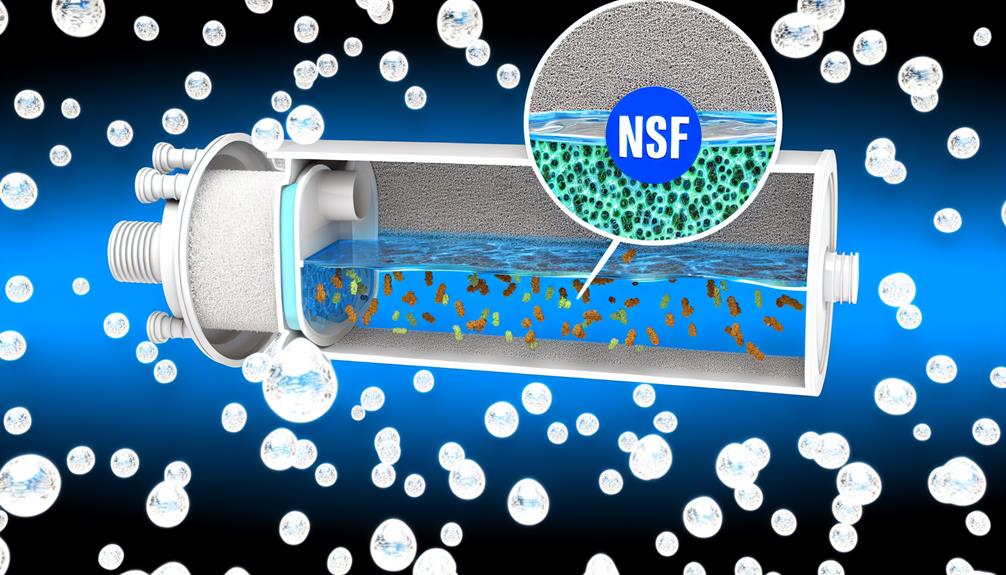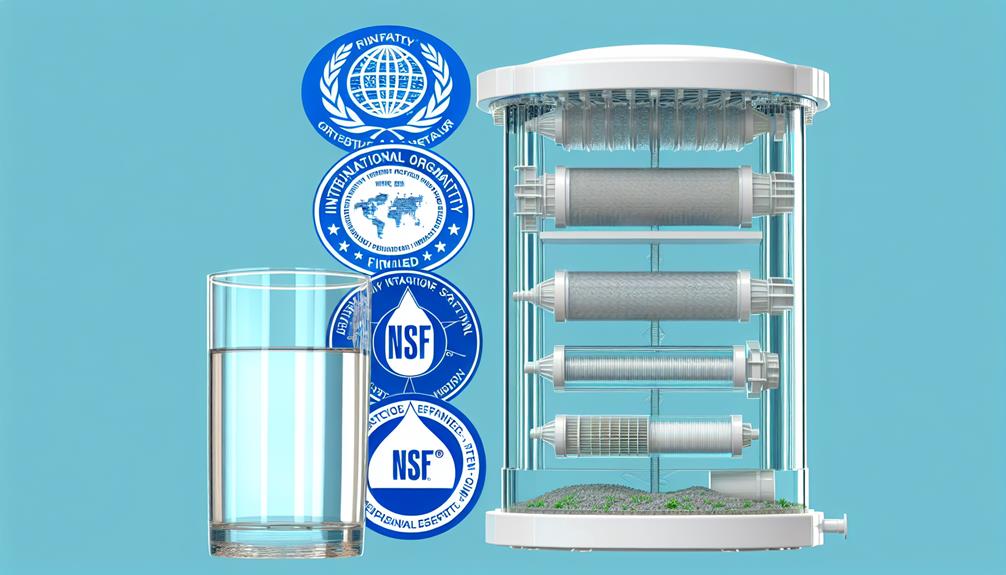As you navigate the murky waters of securing lead removal certifications for filters, it's vital to keep a steady hand on the helm. You're tasked with ensuring that the filters you offer are not only up to par but certified by the most stringent standards. This journey isn't just about ticking off a list; it's about safeguarding health and building trust with consumers who rely on you for clean drinking water.
Understanding the ins and outs of certification bodies, identifying relevant standards, and verifying filter performance are just the tip of the iceberg. To truly ensure your filters stand up to scrutiny, you'll need to maintain accurate documentation, engage in regular testing, and ensure manufacturing consistency.
As you prepare to steer your product through these rigorous processes, remember, the devil is in the details—and it's these very details that can make or break your success in achieving certification. With these nine tips as your compass, you're well on your way to not only meeting but exceeding industry expectations.
So, where do you start, and how can you ensure that you don't overlook any crucial steps in this complex process?
Understand Certification Bodies
When choosing a water filter, it's crucial to consider the certification bodies, like NSF International and WQA, that validate a filter's ability to effectively remove lead. These organizations are dedicated to certifying drinking water treatment products and ensuring they meet rigorous health and safety standards. Look for filters certified to reduce lead, as this indicates they've passed stringent tests.
NSF International, in conjunction with the American National Standards Institute (ANSI), has developed standards like NSF/ANSI Standard 53 and NSF/ANSI Standard 58. Filters that meet these standards have undergone independent testing and certification to verify their lead removal efficacy.
The Certified Product Listings provided by these bodies serve as a Consumer Guide for selecting a reliable filter.
Identify Relevant Standards
To safeguard your drinking water quality, it's essential to select water filters that adhere to recognized standards such as NSF/ANSI Standard 53 for lead removal. When you're in the market for a certified water filter, you want to be sure it's tested and certified to remove lead effectively. Always look for the NSF/ANSI 53 mark, which assures you that the product has been rigorously tested by an independent organization such as NSF International.
Here are three critical steps to ensure your filter meets the necessary standards:
- Verify Certifications: Check the filter's certification against the NSF/ANSI 53 standard. Only trust filters that are listed on official Product Listings for Lead.
- Assess Contaminant Reduction: Ensure the filter is specifically certified to remove lead, as some filters target different contaminants.
- Review Performance Data: Look for performance data that demonstrates the filter's capacity and flow rate, ensuring they align with National Standards Institute (ANSI) guidelines.
Following these steps guarantees that the water filter you choose is aligned with the latest standards development in water filtration technology. Always prioritize products that have been certified to offer you and your family the safest drinking water possible.
Verify Filter Performance
You must assess the filter's ability to reduce contaminants, ensuring it complies with recognized certification standards. Look for filters that meet NSF/ANSI Standard 53 or 58, which are benchmarks for lead removal efficacy.
Additionally, regular testing of your water will confirm that the filter continues to perform as expected, safeguarding your household's water supply.
Assessing Contaminant Reduction
Regular water testing is crucial to verify the performance of your filter in reducing contaminants, particularly lead. When evaluating and certifying drinking water filtration systems, consider these vital steps:
Utilize Home Testing Kits: Regularly use testing kits to monitor your water for lead and other contaminants, ensuring the filter's lead reduction capabilities align with standards.
Professional Assessments: Engage professional services for comprehensive water testing to validate that your filters certified meet or exceed NSF/ANSI 53 or NSF/ANSI standards for the reduction of contaminants.
Certification Verification: Periodically confirm that your water filtration system remains testing and certified, safeguarding your health by ensuring the consistent and effective removal of harmful contaminants.
Certification Standards Compliance
Why should you confirm that your water filter complies with certification standards such as NSF/ANSI 53 or NSF/ANSI 58 before making a purchase?
Ensuring your filter is certified to NSF/ANSI standards means it meets rigorous requirements for lead removal. Reputable bodies, such as the NSF, WQA, or IAPMO, must have independently tested and certified it.
This testing typically costs manufacturers time and resources, but it provides critical consumer information. When a filter is certified, it's not just a claim; it reflects that the product adheres to the specific requirements of the standard, as recognized by the Environmental Protection Agency.
Invest in a filter certified for your safety and peace of mind.
Maintain Accurate Documentation
Ensuring your filter's lead removal certifications and associated documentation are meticulously updated and managed is crucial for compliance with safety regulations and standards. As you strive to reduce lead in drinking water and maintain high-quality water standards, here are essential documents you should keep in pristine order:
- Certification Records: Preserve all records proving your filters are certified to remove lead. This includes initial certifications and any renewals.
- Water Quality Reports: Regularly update your water quality reports to reflect the performance of your filter cartridges in reducing lead content.
- Health and Safety Audits: Document any state or local health and safety audits or inspections, including any corrective actions taken.
Engage in Regular Testing
Beyond maintaining accurate documentation, it's crucial that you conduct frequent water testing to verify your filter's effectiveness in removing lead and safeguarding your water quality. You must be proactive in using test kits designed for detecting lead in drinking water. These kits can be a first line of defense, enabling you to promptly identify and reduce the presence of lead.
Remember, while home test kits offer a convenient monitoring tool, they can't replace the detailed analysis provided by professional drinking water treatment systems. To ensure your filter continues to perform optimally, engage the services of a certified laboratory for comprehensive testing. This will give you a precise assessment of your tap water and the efficacy of your water filters.
Regular testing not only confirms the removal of lead but also reassures you that other harmful contaminants are being addressed. It's a critical step in the maintenance routine for any filtration system. By establishing a schedule for periodic water quality assessments, you're taking a significant step toward ensuring the health and safety of those who rely on your filtered water.
Keep in mind that the goal is to maintain a consistent standard of water purity, making regular testing an indispensable practice.
Ensure Manufacturing Consistency
To maintain the high standards of lead removal that consumers expect from your filters, it's critical to adhere to rigorous quality control processes throughout the manufacturing cycle. Making sure the filter consistently performs to specifications is non-negotiable, as filters reduce lead and ensure the safety of the water supply.
Here are some vital steps to guarantee manufacturing consistency:
- Implement Standardized Protocols: Establish and follow standardized procedures at all stages of filter production to ensure each system for the reduction of lead meets or exceeds industry standards.
- Maintain Equipment Precision: Regularly calibrate and service manufacturing equipment to maintain a consistent output, ensuring that each filter meets the parts per billion requirements for reducing lead.
- Perform Quality Assurance Checks: Conduct comprehensive testing and quality checks during production to confirm the efficacy of lead removal, making adjustments as necessary to uphold performance.
Train Your Team Thoroughly
A well-trained team is the cornerstone of maintaining the integrity of lead removal certifications for water filtration systems. Ensuring your personnel are thoroughly knowledgeable about the various types of filters, especially reverse osmosis systems, is critical. These systems are highly effective at removing lead, which is crucial when high levels of lead present a risk to water for drinking.
Your team must understand the importance of filters' ability to eliminate contaminants, thereby protecting your family and consumers. Training should cover the selection of certified filters that are proven to be effective in removing lead. It's not just about making a sale; it's about providing safe, filtered water that meets stringent health standards.
Emphasize the critical role of regular testing and maintenance to ensure the consistent performance of water filtration systems. This diligence is key to uphold lead removal certifications. Make sure your team grasps the testing protocols and certification processes that validate a filter's claims.
Stay Updated on Regulations
You must stay vigilant about monitoring regulatory changes to ensure your water filters meet compliance standards for lead removal. Regularly review updates from authoritative bodies like NSF International and the Water Quality Association (WQA) to stay on top of certification requirements.
Understanding the evolving compliance landscape is crucial for making informed decisions about your water filtration systems.
Monitor Regulatory Changes
Regularly monitoring official government websites and industry publications is essential for staying abreast of the latest regulatory changes in lead removal certifications for filters. Here are steps to ensure you're informed:
- Subscribe to Newsletters: Sign up for newsletters and alerts from bodies like the Environmental Protection Agency to receive timely updates on regulations affecting lead in your drinking water systems.
- Join Industry Groups: Engage with industry organizations and attend relevant conferences to gain insights into public health concerns, such as lead exposure and the removal of contaminants from drinking water.
- Consult Experts: Consider the expertise of regulatory consultants who specialize in navigating water systems regulations and can interpret the impacts of changes mandated by health organizations.
Staying informed is critical to ensure your products meet the latest standards and protect public health.
Understand Compliance Standards
Staying abreast of regulatory changes is crucial to thoroughly understanding the compliance standards that govern lead removal certifications for water filters.
As you delve into the specifics, remember that these regulations are designed to safeguard public health by ensuring that drinking water is free from harmful contaminants, including lead.
Compliance standards dictate the maximum amount of lead that filters can permit in treated water. Consumer safety is paramount, so it's imperative that your products not only say they meet these standards but are also independently verified to do so.
Keep an eye on any updates or amendments, as these could impact your certification status.
Apply for Certification Renewal
To maintain the validity of your lead removal filter's certification, it's essential to initiate the renewal process well before the current approval expires. Certifications aren't just pieces of paper; they're assurances that your water systems, including filters for hot water and cold water, meet rigorous safety standards.
Here's a concise list to keep in mind for a smooth renewal:
- Check the Expiration Date: Verify the date when your certification for lead removal—whether it's for a sink faucet or a whole-house system—will lapse.
- Gather Documentation: Compile all necessary records, including performance data and proof of compliance with Lead-based Paint regulations if applicable.
- Submit Renewal Application: Complete and submit the application to the certifying body, ensuring all details are accurate and that you've included any updates to your systems.
Staying proactive is crucial; don't wait until the last minute. Certifications are your pledge to safety, a promise that your filters effectively remove lead from water. Make sure to stay on top of renewal deadlines to avoid disruptions in your service.

